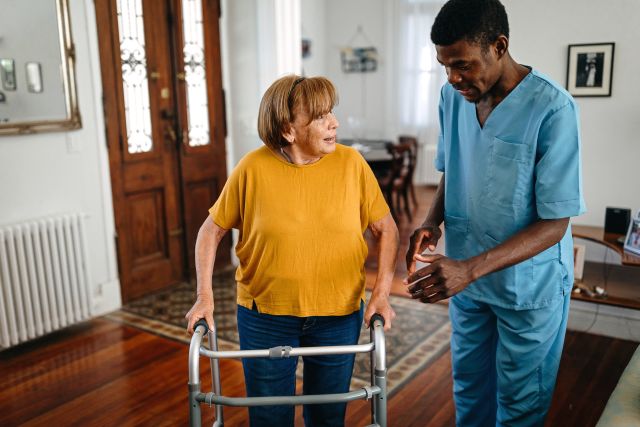Updated on March 12, 2024.
For people with chronic pain, injuries, disabilities, and certain health conditions, everyday activities, like participating in work or school or completing household chores, can be extremely difficult. Occupational therapy (OT) is a type of therapy that focuses on developing the strengths and skills required for routine tasks and activities. It helps people with these conditions function independently and safely in their daily lives. This, in turn, could improve overall health and quality of life.
What is occupational therapy, exactly?
Despite its name, the goal of occupational therapy isn’t only to help adults improve the skills they need to perform effectively at work. Rather, occupational therapy examines the various roles (otherwise known as “occupations”) that all people assume each day. Then, it considers how they can be affected by disabilities, injuries, and certain health events, like stroke or a cancer diagnosis.
“If you’ve had a stroke, for example, it’s going to interfere with your occupations as someone’s wife, mother, grandmother, neighbor, friend, or coworker,” explains Mary Kennedy, OTR/L and Inpatient Rehab Services Supervisor with Citrus Memorial Hospital in Inverness, Florida. “Your stroke has disrupted all of these occupations—all of those hats that you wear—and the activities related to them.”
Because occupational therapy takes a holistic approach to treatment, your therapist won’t only examine the condition or health event that’s interfering with your occupations. They'll also examine why it’s important for you to participate in each of these roles.
“A therapist will ask a patient, ‘What’s important to you? Why are you here? What do you want to be able to do after your occupational therapy?’ Kennedy says. She provides a sample scenario: Let's say someone fractures their wrist and wants to play golf or another sport, or be able to do household chores.
- First, an occupational therapist will create a custom splint to protect the fracture as it heals.
- Then, the person's healthcare provider (HCP) will determine how long the splint must be worn.
- Finally, once the fracture is healed, the occupational therapist will help the person regain the range of motion and strength needed for everyday tasks and hopefully, other activities.
How occupational and physical therapies differ
Occupational therapy and physical therapy share many similarities. For example, both are rehabilitation programs that aim to boost your independence, self-reliance, and safety. But there are some key differences.
“Occupational therapists focus primarily on activities of daily living, or the things we do in our everyday lives: Bathing, dressing, toileting, being able to cook our own meals or wash our clothes—the things we take for granted when everything is working right,” says Kennedy. “Physical therapy focuses more on the ability to walk safely or on issues of functional mobility.”
Occupational therapy treats the whole person, whether they’re recovering from an injury or living with a developmental or cognitive disability. Overall, occupational therapists aim to help people more fully engage in daily life. Physical therapy, on the other hand, tends to approach treat the actual cause of a condition—like a broken bone or torn ligament—with special exercises and massages, among other therapies.
Physical therapists and occupational therapists often work together, taking a “team approach” to rehabilitation.
Who could benefit from occupational therapy?
Occupational therapy can be applied to a number of physical, emotional, and cognitive issues. It can help people of all ages, ranging from infants to older adults. Just a few conditions often treated with occupational therapy include:
Stroke: Many people experience significant changes in function after a stroke. An occupational therapist can address issues like weakness, loss of mobility and coordination, and emotional distress by reteaching self-care skills and addressing physical issues with certain exercises. An occupational therapist could also support mental and social well-being by helping someone develop good coping strategies, which might include relaxation techniques.
Autism: Although many children with autism don’t require occupational therapy, it can help some kids improve their fine motor skills, hand-eye coordination, self-care skills, and socialization. It can also address challenges like sensory and hypersensitivity issues, adds Kennedy.
Chronic pain: Occupational therapists can teach those with chronic pain to essentially “redirect” their pain, so it isn’t as disruptive to daily life. Some therapies for chronic pain may include relaxation techniques, gentle exercises, or meditation.
Developmental disabilities: Kids develop at different rates, but if your child isn’t reaching typical monthly developmental milestones, occupational therapy could help. An occupational therapist may recommend muscle-building exercises or therapies that can strengthen sensory systems.
Low vision: “Glaucoma and other eye diseases can interfere with your ability to look up a phone number, read a recipe, or drive,” says Kennedy. If you have impaired vision, an occupational therapist can help you maximize your ability to function while minimizing your risk for injuries. This may include recommending new lighting, or suggesting the use of grab bars, magnifiers, or other tools. It may also involve teaching new vision tracking or scanning techniques and pointing out potential fall hazards in your home environment, such as clutter, cords, or throw rugs.
In general, occupational therapy may include:
- Teaching use of assistive devices, like splints, braces, walkers, or canes
- Making changes to your home or office, so they’re conducive to your condition
- Helping people relearn higher-level self-care techniques, like cooking healthy meals, paying bills, or completing household chores
In some cases, people undergoing occupational therapy may be offered classes, which can help them understand the rehab process, notes Kennedy who is involved in the Joint and Spine Academy—a similar program at Citrus Memorial.
“Patients are provided with information, including a home exercise program to help prepare them for their surgery and rehab,” she says. Programs such as these are just another way occupational therapy can help patients get back to all of their “occupations,” Kennedy adds.
Programs are personalized
There are a wide range of applications for occupational therapy. But it’s important to note that each program is highly customized for your condition, lifestyle, and goals. In other words, no two people will undergo the same occupational therapy program or have the same experiences, even if they have the same health challenges.
The results of occupational therapy can also vary greatly from person to person, but how you approach occupational therapy is key. “Attitude is 90 percent of it,” says Kennedy. “If you have a good attitude, are positive and work hard, you’re going to see a lot of changes. You have to put in 100 percent effort.”
If you’re interested in developing an occupational therapy program for yourself or a loved one, talk to an HCP. They'll help determine whether or not occupational therapy is the right course of treatment.






